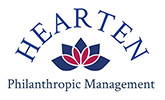Hearten Philanthropic Management
At Hearten Philanthropic Management we are dedicated to helping charities, businesses and individual donors make the most of their philanthropic efforts. We can help you wherever you are in Canada and have a network of experts ready to assist you in making your dreams come true.
What we do
Capital Campaigns
Capital campaign can be your charity’s greatest fundraising effort, but it does not have to be painful. We can help make sure you are prepared and have a clear solid plan to meet your goals.
Feasibility Studies
A key element in any capital campaign is a solid Feasibility Study. It not only gauges public support and prepares your organization, but is also an essential way to enlist key supporters to your team. We can guide you through the process of making your Feasibility Study work for you.
Annual Campaigns
Every charity needs a solid Annual Campaign to keep services growing and the bills paid. We can help create or fine tune your annual fundraising and set you up for success.
Team Training
Do you have a good team that you want to be great? We can access your training needs and can build your capacity to deliver both services and donors.
Board Coaching
Most board members have little training in the essentials of leading a charity. They may be leaders of government or business, but leading a charity is quite different. We can get your board (and senior volunteers) to new peaks of leadership. We can also help them enjoy their duties as the key leaders of your charity.
Organizational Audits
Are you not sure what you need or what you are missing? We can help with full organizational or individual program audits to make your current activities more effective and your future clear.
Defining Your Community Focus
Do you want to make the best impact for your dollar? We can help your leadership define the path that is best for you, your employees and your community.
Sponsorship Program Development
Clearly defined goals, processes and resources are important for every part of your business. We can help you build a strong sponsorship program that is good for you and the community you support.
Program Audits
Do you already have a community support program and not sure how to make it work better? We can help you define what your public thinks, what your staff needs, and what your leadership has to do to make your impact the best it can be.
What are the most effective ways to give?
Donating to charities should bring you joy. Should you set up a Family Foundation? Should you set up a Donor Directed Fund at a community foundation? Should you give gifts that are used right away or are Endowed Funds best for your aims? Want to develop your family’s philanthropic culture in a way that lasts for generations? We can help you make the most of your donations, today and in the future.
How do you choose the most effective charities?
Do you ever wonder how effective the charities you support are? What is acceptable for administration and fundraising costs? Are the charities you support reporting what they do and spend accurately? We can help you find the answers you need.
Subscribe
Sign up to receive email updates

